Monthly Archives: May 2020
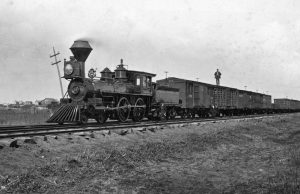 Flood waters carry with them more damage than people imagine. Water just doesn’t seem like the force it can become. That was exactly what had happened in May of 1878. The flood waters came rushing down the creek overnight, and the force of the water had wiped out a bridge at Box Elder, Montana. The section foreman discovered the missing bridge and rushed to secure a red light for the purpose of signaling the Kansas Pacific freight train. He knew the train was due any minute. Before he could avoid the approaching disaster, the train thundered down upon the chasm left by the missing bridge, and into the torrent of wild waters below.
Flood waters carry with them more damage than people imagine. Water just doesn’t seem like the force it can become. That was exactly what had happened in May of 1878. The flood waters came rushing down the creek overnight, and the force of the water had wiped out a bridge at Box Elder, Montana. The section foreman discovered the missing bridge and rushed to secure a red light for the purpose of signaling the Kansas Pacific freight train. He knew the train was due any minute. Before he could avoid the approaching disaster, the train thundered down upon the chasm left by the missing bridge, and into the torrent of wild waters below.
The accident occurred about 12 o’clock that Tuesday night, three employees lost their lives, and a whole freight train was totaled. John Bacon, of Denver, who was the engineer; his fireman, Frank Sellvin, and another employee named John Piatt, were in the engine, and unable to escape. The whole train had eighteen cars. The fatal blow came when the car that was loaded with railroad iron, came to rest on top of the wreck, burying the men piled upon the wreck and buried the men. They might as well have been buried beneath a mountain. The crews knew it would be several days before they would be able to remove the bodies from the wreckage. Nevertheless, given the way the iron car fell on the engine, it was certain that the three men died instantaneously…or nearly so.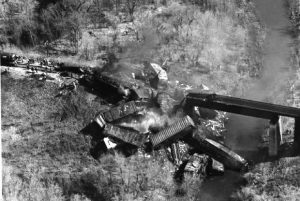
In a bizarre twist, the body of Frank Sellvin turned up, not under the wreckage, but a mile and a half from where that accident occurred. It appeared that he jumped from the engine as it fell. While trying to save himself, he was instead carried by the raging torrent out of the reach of the wreck, but not out of the clutches of the killer flood waters. By midnight the bodies of the other two men were still missing. It would be a while yet before their bodies would be found. Water seems like something so innocent, but when they become flood waters, they become killer waters.
 My son-in-law, Travis Royce has surprised me over the years. He didn’t do it intentionally, but rather he just turned out to be different than what I expected him to be. When he and my daughter, Amy live in Ferndale, Washington these days, out in the country, which is totally not what I expected of them. They just didn’t seem the type when they first got married in 1995. Of course, they were kids then, and they were into the typical things that young people were. They music they liked was different than the music I like…well, it still is, so I guess that hasn’t changed. Still the music they like doesn’t normally seem typical of country living.
My son-in-law, Travis Royce has surprised me over the years. He didn’t do it intentionally, but rather he just turned out to be different than what I expected him to be. When he and my daughter, Amy live in Ferndale, Washington these days, out in the country, which is totally not what I expected of them. They just didn’t seem the type when they first got married in 1995. Of course, they were kids then, and they were into the typical things that young people were. They music they liked was different than the music I like…well, it still is, so I guess that hasn’t changed. Still the music they like doesn’t normally seem typical of country living.
Travis is a very social person, another thing that doesn’t seem to fit with country living, but there is another side to Travis too. The side that loves the peace and quiet he finds in his back yard in the country. He loves sitting out in the back yard watching a fire in 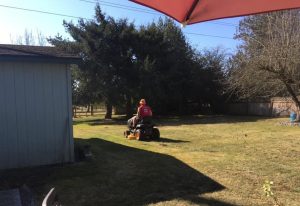 their fire pit. He feels so relaxed there. Don’t get me wrong, Travis still likes to go out, have a few drinks with friends, and do a little gambling, but it’s almost like the ranch family going out to a square dance on a Saturday night, and afterward, head back home to country living. The fact is that as often as not, Travis would rather have people over at their house that go out. When their kids, Shai and Caalab come over, Travis enjoys playing the guitar with Caalab, while the girls sing. I’ve had the privilege of attending some of their little impromptu concerts, and they are
their fire pit. He feels so relaxed there. Don’t get me wrong, Travis still likes to go out, have a few drinks with friends, and do a little gambling, but it’s almost like the ranch family going out to a square dance on a Saturday night, and afterward, head back home to country living. The fact is that as often as not, Travis would rather have people over at their house that go out. When their kids, Shai and Caalab come over, Travis enjoys playing the guitar with Caalab, while the girls sing. I’ve had the privilege of attending some of their little impromptu concerts, and they are 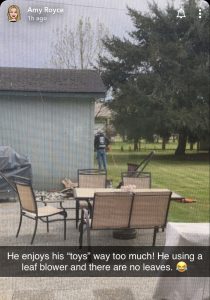 really good. The whole family has talent, and that makes it a lot of fun.
really good. The whole family has talent, and that makes it a lot of fun.
Because Travis loves yard work…or at least mowing the lawn, their yard always looks amazing. And Amy loves flowers, so she adds her special touches, and the effect of lovely. I can understand why they like being out there in the peaceful beauty of their back yard, because I have been there myself and it is very peaceful. Travis loves his yard work so much, and his yard tools too. In fact, that was never more evident than recently when he went out in the back yard and started using his leaf blower. there were no leaves to blow away, so Amy thought the picture was quite comical. Maybe it was, but I think it is also very much Travis. My guess is that while he wasn’t blowing leaves away, h might have seen some dirt or pine needles, and decided that the leaf blower was the best tool for the job. It’s as simple as that. Today is Travis birthday. Happy birthday Travis!! Have a great day!! We love you!!
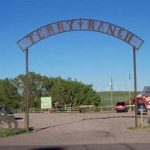
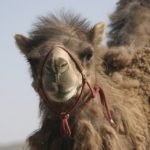 If you find yourself south of Cheyenne, Wyoming just north of the Colorado border, and you look to the east of I-25, you might be surprised to see several camels grazing in the fields there. The first time I saw it, I was very surprised, although it is not unheard of to bring animals from one area of the world to another, where it is not common to see such an animal. Nevertheless, it was not a sight that I had seen before.
If you find yourself south of Cheyenne, Wyoming just north of the Colorado border, and you look to the east of I-25, you might be surprised to see several camels grazing in the fields there. The first time I saw it, I was very surprised, although it is not unheard of to bring animals from one area of the world to another, where it is not common to see such an animal. Nevertheless, it was not a sight that I had seen before.
This isn’t the first time camels have spent time in the United States, however. In the mid-1800s, someone else came to the conclusion that camels might be a good alternative to horses or donkeys in the deserts of the Southwest. Camels can go for long periods of time without water, and I’m sure that fact played a part in the decision. The camels were to be used in Arizona, New Mexico, and the deserts of the Colorado River. Some thought it might be a way to revolutionize travel and transportation over the American deserts. That thought is almost insane, considering what I have heard of the temperament of camels.
Jefferson Davis of the Southern Confederacy was the chief promoter of the project. In the last session of Congress in 1851, the army appropriation bill was under consideration. Then, Senator Davis from Mississippi, offered an amendment providing for the purchase and introduction of 30 camels and 20 dromedaries…which are two-humped camels, with ten Arab drivers, and the necessary equipment. Davis spoke of how these animals were used just like donkeys in countries in Asia and Africa. He mentioned that they were used by the English in the East Indies for the transport of army supplies, and other places where their use had been touted.
Davis also thought camels might be used effectively against the Indians on our Western frontier, because they could drink enough water before they started a trip to last for one hundred miles. Then, the camels and soldiers would travel continually without the need of rest. Camels travel at a rate of ten to fifteen miles an hour, so they could catch up to these bands of Indians…a feat the cavalry had been unable accomplish.
The transport ability of the camel was not in question, because they could do the same things here that they were capable of doing in the East. Camels are used to eating brush and scrubs, and drinking the same kind of brackish water which existed in some portions of our Western deserts. In the end the group promoting the use of camels misjudged the workability of the camels…at least as it applied to their use without bringing the Arab handlers over to work the camels.
It seemed that the camel was going to be the greatest thing to arrive in years, but those who promoted the scheme, forgot about the downsides of using camel labor. One fatal mistake was that they figured only on the camel’s virtues. Camel’s can be uncooperative and difficult to work with. Another mistake they made was in not bringing in the Arab drivers with the camels. The people in America, who were going to be handling the camels really had no idea what they were up against. It was like telling an attorney to perform surgery. Both the American mule-whacker and the Arab camel driver were skilled at their jobs, but they were doing a job they were not trained for. It can become a recipe for disaster. From the very first meeting of the camel and the American mule-whacker, who was to be his driver, there developed between the two a mutual antipathy, and lets face it, antipathy is not a good thing in relation to working together to reach a goal. Really, to be a successful camel driver, a man must be born to the business. This is a trade that is often passed down from generation to generation.
The camel’s mild submissiveness, rather than appealing to his drivers, seemed instead to provoked them. They understood the vigorous kicking of an army mule in his protest against abuse, but the spiritless dejection and the mild-eyed pensiveness of the Arabian burden-bearer was exasperating. While the camel seemed to want to please, their ability to show pure meanness came to the forefront when pushed too far. One lone camel could stop the work of an entire herd simply by showing that his stubbornness was just as strong as that of a mule. Also, either they were clumsy when it can to close quarter or something, because when two of these heavily laden “ships of the desert” collided on a narrow trail, as they always did when an opportunity offered, tons of supplies were scattered over miles of plain and the unfortunate camel pilots had to gather up the cargo of the wreck. Whenever that happened, the handlers cursed the whole camel race.
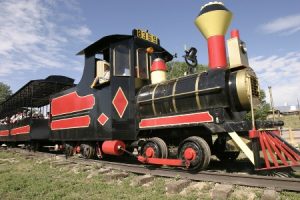
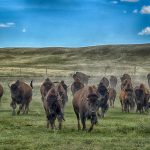
I’ve never stopped in to see the camels at the Wyoming-Colorado border, so I don’t know if these camels are as contrary as the ones used in the 1800s, but I think it would be interesting to see a camel up close anyway. Maybe one of these days I will do just that. The Terry Bison Ranch’s custom-built trains take you to see ostriches, camels, a huge bison herd, and actually hand-feed the bison! Sounds interesting to me.
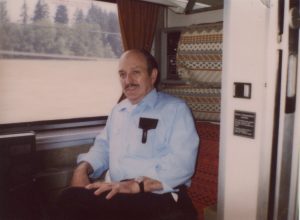 My dad, Al Spencer loved trains. I’m sure it all started with his dad’s job as a carpenter on the Great Northern Railway. Dad and his siblings rode the trains to school and such. It was one of the perks of his dad’s job. I know most kids like trains, but I think Dad maybe liked them more than most kids. He grew up around them.
My dad, Al Spencer loved trains. I’m sure it all started with his dad’s job as a carpenter on the Great Northern Railway. Dad and his siblings rode the trains to school and such. It was one of the perks of his dad’s job. I know most kids like trains, but I think Dad maybe liked them more than most kids. He grew up around them.
On May 1, 1971, a very exciting event took place, especially for my dad. It was on that day that the Amtrak train was born. It was originally established by the Congressional Rail Passenger Service Act, which consolidated the United State’s existing 20 passenger railroads into one. Of course, most of us know that the Amtrak train has since had a long history…49 years to be exact. Back then the Amtrak train line served 43 states with a total of 21 routes. These days they not only handle traditional interstate passenger rail in 46 states, but they also operate high-speed trains along their busiest route, the Northeast Corridor from Washington DC, to Boston. With more than 500 destinations throughout a 21,000 mile system, Amtrak has grown to 33 routes across America. Nevertheless, the Amtrak train system was always focused on getting from Point A to Point B safely and swiftly, even in 1971.
From the time that first Amtrak rolled out of the station, my Dad was hooked. He knew he wanted to take a trip by way of that train. During the early years of the Amtrak, we heard a lot about it. It wasn’t going to be a trip that we went on as a family, but rather a special trip for Dad and Mom. That trip would finally happen in about 1991, when Mom and Dad took the Amtrak from San Diego to Seattle. My sister, Caryl Reed and her family lived there at the time, and they would spend time visiting with them after the train ride. My dad was so excited!! In fact, he was the epitome of “the kid in the candy shop.” I can see why he would be so excited. After 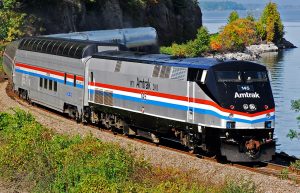 all, he had waited twenty years for that trip. I suppose that prior to that time, he couldn’t think of any reason to take the trip, but when my sister moved to Bremerton, Washington, the time had come. Mom and Dad made many trips to Washington in those years, but that trip on the Amtrak Train really was the most exciting way for them to travel.
all, he had waited twenty years for that trip. I suppose that prior to that time, he couldn’t think of any reason to take the trip, but when my sister moved to Bremerton, Washington, the time had come. Mom and Dad made many trips to Washington in those years, but that trip on the Amtrak Train really was the most exciting way for them to travel.
I can picture my dad now. Not how he looked. I have a picture of that. No…I can picture how he felt. He was that “kid in the candy store” again. I could picture him feeling like he was back in Superior, Wisconsin, hopping the train, even though he had a pass to ride the train.

